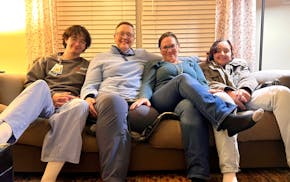The professor and his students navigated the aisles of Axman Surplus, collecting bits of salvaged hardware, circuits, electrical components.
Something old to build something new.
Steven Saliterman, a professor in the Department of Biomedical Engineering at the University of Minnesota, and a small group of undergraduates were building a new medical device from scratch. He often worked with students on inventions and innovations, but this time they were answering a call for help.
Reynaud's phenomenon is a frustrating and sometimes painful condition that causes blood vessels to contract, decreasing circulation to the extremities — particularly in cold weather. Bad news for sufferers in frigid Minnesota as their fingers, toes, ears or noses turn bone-white or blue.
One of Saliterman's colleagues, a doctor, reached out. His wife, who has Reynaud's, wondered if anyone at the U was working on a device, not a drug, that could treat or prevent the uncomfortable symptoms. There had been some promising studies into the possibility of light therapy, but no one had tried to develop a treatment for humans — yet.
Saliterman and his students took up the challenge. It was 2017.
Creating new medical technology when "there's no formal funding and no formal lab to work in, because they're undergraduate students, is a real challenge," Saliterman said. "You have to say, 'We're going to make this work, we're going to find what we need, we're going to scrounge. Whatever it takes.'"
Brett Levac was a sophomore majoring in electrical engineering when he joined the project. He remembers riding the light rail to Axman, scrounging for technology to use.
"In the beginning, it was looking for components … to see what we could Frankenstein together," he said.
Bit by bit, they built the first prototype, then the next, then the next. Devices that looked a bit like high-tech toaster ovens. They custom-built sensors, pored over research and data and navigated reams of paperwork and permissions, hoping the technology would lead to a wearable device that could treat or even prevent Reynaud's symptoms.
When the pandemic shut down most research trials at the U, the student inventors used the fingers they had available to test the device. Their own.
"In the great tradition of Edward Jenner, who tested the smallpox vaccination on himself, not knowing if it would kill him or not, our students and Dr. Saliterman stuck their arms and hands in the device and they're all still here to talk about it," said Dr. Jerry Molitor, who works with patients suffering from systemic sclerosis — a rare autoimmune disease in which most of the patients suffer from severe forms of Reynaud's phenomenon.
The device the students have produced — now patented and likely to head to clinical trials — is "wonderful," said Molitor, who worked as an advisor to the project.
The work the students did on the device shaped the work they want to do in the future.
"Working on this project showed me that I like trying to create new things," said Levac, who is doing most of his creating in code these days, working toward his Ph.D. in electrical engineering at the University of Texas in Austin.
The project — and the people it brought together from so many different fields of study — inspired Emily Wagner, who was enrolled in the school of nursing when she first signed on. The research, and the many factors that can cause disease, fascinated her; she changed her major to physiology. She is now pursuing a master's degree in public health, with an eye toward medical school down the road.
James Kerber dived into the piles of paperwork that underpin any study and found that he had a knack for navigating arcane rules, paper trails and bureaucracy.
Looking up rules, working with different offices and agencies, made him realize, "Yeah, I kind of enjoy this," he said. He decided to go to law school — an inventor with a patent, studying patent law.
"I did my bachelor's and master's in biomedical engineering during this project and then, partly because of this project, I am in law school," said Kerber, who is in the middle of law school finals this week.
The authors of the project and the University of Minnesota received a utility patent (U.S. 11,865,357) for the light-based treatment device they developed. The project was published in the Annals of Biomedical Engineering in late March.
And then, finally, Saliterman could reach out to the physician who reached out to him six years ago.
"He was just elated," Saliterman said. "The first thing he said was, 'I had no idea how much work it would take you.'"
To read about the Reynaud's project in detail, visit: saliterman.umn.edu/special-project-team.

Brooks: At last, English is the official language of the United States of Some Italian Guy's First Name

Brooks: With the overnight snowstorm, Minnesota looks like Minnesota again

Brooks: Gay marriage worries motivate Minnesota wedding bash plans


![BRIAN PETERSON ¥ brianp@startribune.com St. Paul, MN 9/24/2009 ] A lone kayaker makes his way from the Minnesota River into the Mississippi near Pike](https://arc.stimg.co/startribunemedia/O7Z6YC6SRE6G4XOBWQNICI7WUU.jpg?w=600&h=600&auto=format%2Ccompress&cs=tinysrgb)